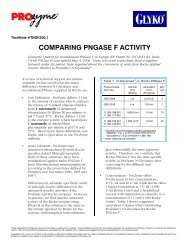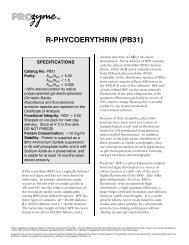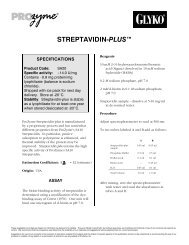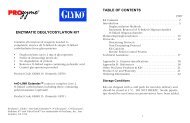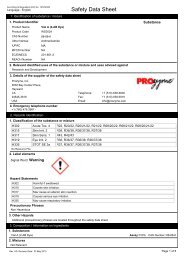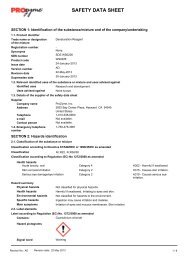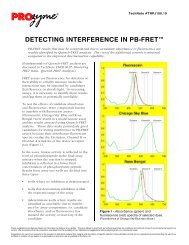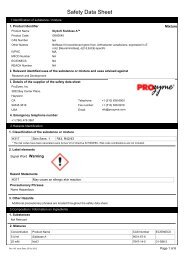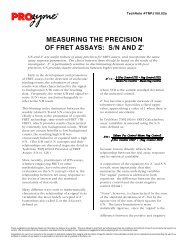Activated R-Phycoerythrin - ProZyme
Activated R-Phycoerythrin - ProZyme
Activated R-Phycoerythrin - ProZyme
Create successful ePaper yourself
Turn your PDF publications into a flip-book with our unique Google optimized e-Paper software.
®<br />
PHYCOLINK ACTIVATED RPE<br />
SPECIFICATIONS<br />
Product Code: PJRC10<br />
A 566/A 280: 5.0<br />
Concentration: 9.5 - 10.5 mg/ml<br />
Conjugation Performance: 50%<br />
incorporated in a standard antibody<br />
conjugation.<br />
Shipped with cold pack for next day<br />
delivery.<br />
Store at 4C (dark) DO NOT<br />
FREEZE<br />
Formulation: Supplied in<br />
50 mM MES, 2 mM EDTA (pH 6.0)<br />
with 1 g/ml pentachlorophenol.<br />
Stability: Stable at least 6 months<br />
when stored properly.<br />
<strong>ProZyme</strong> continually strives to offer the<br />
highest quality materials. With PJRC10, the<br />
activation reaction has been optimized to yield<br />
an activated R-<strong>Phycoerythrin</strong> that produces even<br />
brighter conjugations and lower background.<br />
® ®<br />
<strong>ProZyme</strong> PhycoLink SMCC-<strong>Activated</strong><br />
R-<strong>Phycoerythrin</strong> (<strong>Activated</strong> RPE) is a highly<br />
fluorescent phycobiliprotein, which has been<br />
chemically activated for easy conjugation to<br />
immunoglobulin molecules or other sulfhydrylcontaining<br />
proteins. The sulfhydryl-reactive<br />
group is maleimide and readily reacts with free<br />
cysteine residues under mild conditions of<br />
temperature and pH.<br />
PhycoPro RPE is treated with SMCC under<br />
conditions that result in only a few SMCC<br />
modifications to each protein. This derivatized<br />
protein has been purified to remove excess<br />
SMCC. It is stable for extended periods of time;<br />
SMCC-activated phycobiliproteins have been<br />
stored in MES buffer for up to 1 year at 4C<br />
while retaining conjugation reactivity.<br />
Background<br />
RPE was originally isolated from red algae and<br />
has not been found in other taxa. Its primary<br />
absorbance peak occurs at 566 nm with<br />
secondary peaks at 496 and 545 nm; the relative<br />
prominence of the secondary peaks varies<br />
significantly among RPEs from different species.<br />
RPE has three types of subunits: (~20,000<br />
daltons), (~20,000 daltons) and (~30,000<br />
daltons). The molecular weight of intact RPE has<br />
been found to be about 240,000 daltons, and a<br />
subunit structure of () 6 has been determined.<br />
The subunit of RPE contains only the<br />
phycoerythrobilin (PEB) chromophore, while the<br />
and subunits contain both PEB and phycourobilin<br />
(PUB).<br />
Variability in the absorbance spectra of RPEs<br />
from various species reflects differences in the<br />
PEB:PUB ratio of the subunits. RPE and closely<br />
related BPE are the most intensely fluorescent of<br />
the phycobiliproteins, with quantum efficiencies<br />
probably in excess of 90%, and its orange<br />
fluorescence is readily visible by eye in any<br />
moderately concentrated solution.<br />
RPE has been used in a variety of immunological<br />
assays and as a fluorescent label for<br />
Fluorescence <strong>Activated</strong> Cell Sorting (FACS).<br />
Unlike small molecule dyes, typically about one<br />
R-phycoerythrin molecule is conjugated per<br />
molecule of antibody. Nonetheless, by virtue of<br />
its high absorption coefficient and almost perfect<br />
quantum efficiency, it is one of the brightest<br />
dyes available today. It emits at about 575 nm,<br />
and can be excited by common argon laser lines.<br />
In addition, because of the high molar<br />
absorptivity of these proteins at visible<br />
wavelengths, they are convenient markers in<br />
such applications as gel electrophoresis,<br />
isoelectric focusing and gel exclusion<br />
These suggestions and data are based on information we believe to be reliable. They are offered in good faith, but without guarantee, as conditions and methods of use of our products are beyond our<br />
control. We recommend that the prospective user determine the suitability of our materials and suggestions before adopting them on a commercial scale.<br />
Suggestions for use of our products or the inclusion of descriptive material from patents and the citation of specific patents in this publication should not be understood as recommending the use of our<br />
products in violation of any patent or as permission to license to use any patents of <strong>ProZyme</strong>, Inc.
chromatography.<br />
Purity and Brightness<br />
The ratio of absorbance at the wavelength of<br />
maximum absorbance to absorbance at 280 nm<br />
(A max:A 280) is often used as a product<br />
specification; it is indicative of the purity of the<br />
RPE with respect to most forms of contaminating<br />
protein. A 280 is primarily due to aromatic amino<br />
acids, and this is roughly proportional to the<br />
total concentration of protein in solution,<br />
including RPE. A 566 ( max for <strong>Activated</strong> RPE)<br />
reflects only the concentration of RPE. However,<br />
A 566:A 280 also indicates the condition of the<br />
phycobiliprotein itself, since highly purified<br />
samples of RPE can vary significantly in this<br />
respect. These differences reflect handling, age<br />
and the source of the original material;<br />
reductions in this ratio probably reflect<br />
deterioration of chromophores.<br />
In seaweed from natural sources or seaweed<br />
farms, proteases become active within minutes<br />
or hours of harvest, and can cause complete or<br />
partial degradation of phycobiliproteins. One<br />
very typical result of partial degradation is a<br />
lowering of the A 566/A 280 ratio. As a result, when<br />
seaweed that has been harvested and then<br />
stored— even if it is stored frozen— the finished<br />
RPE can have an intrinsically lower A 566/A280<br />
ratio, which cannot be increased even through<br />
exhaustive purification. (This is one problem<br />
with the A 566/A 280 ratio as an indicator of purity:<br />
it is an indicator of the condition of the pigment<br />
as well as an indicator of degree of purification.)<br />
When an acceptable reading is obtained, it<br />
indicates that the protein is both pure and in<br />
good condition, but when lower values are<br />
obtained it is not immediately clear whether the<br />
problem is in purification or pigment condition.<br />
<strong>ProZyme</strong> uses only this very high quality RPE,<br />
providing exceptional brightness which remains<br />
throughout subsequent processing to give the<br />
greatest sensitivity to antibody conjugates.<br />
For further information about this or other<br />
phycobiliproteins, visit <strong>ProZyme</strong>’s webpage at<br />
www.prozyme.com.<br />
CHARACTERISTICS<br />
A 566/A 280: 5.0<br />
Extinction coefficient: E = 82<br />
Absorption maximum:<br />
Excitation maximum:<br />
Emission maximum:<br />
Absorbance Spectrum:<br />
566 nm<br />
565 nm<br />
575 nm<br />
Fluorescence Emission Spectrum<br />
(arbitrary units, excitation at 545 nm):<br />
PhycoPro RPE is isolated from a red alga<br />
developed as a source of choice because it yields<br />
one of the most highly fluorescent of the RPEs.<br />
It is cultured in the laboratory to control growth<br />
conditions and nutrition, and to avoid<br />
contamination from extraneous organisms and<br />
wastes found in the open ocean. It is carefully<br />
tended and harvested at the optimal stage of the<br />
growth cycle to assure uniform product characteristics.<br />
The pigment is extracted and stabilized<br />
within minutes of harvest, virtually eliminating<br />
risks from the action of proteases.
REFERENCES<br />
Glazer, A. N. Phycobilisomes: structures and dynamics. Ann Rev<br />
Microbiol 36: 173–198 (1982).<br />
Hardy, R. R. Purification and coupling of fluorescent proteins for<br />
use in flow cytometry. In: Handbook of Experimental<br />
Immunology, 31.1-31.12, 4th ed. (D. M. Weir, L. A.<br />
Herzenberg, C. Blackwell and L. A. Herzenberg, eds)<br />
Blackwell Scientific Publications, Boston (1986).<br />
Kronick, M. N. The use of phycobiliproteins as fluorescent labels<br />
in immunoassay. J Imm Meth 92: 1–13 (1986).<br />
MacColl, R. and D. Guard-Friar. Phycobiliproteins. CRC Press,<br />
Inc., Boca Raton, Florida (1987).<br />
MacColl, R., K. Csatorday, D. Berns and E. Traeger. The<br />
relationship of the quaternary structure of allophycocyanin to<br />
its spectrum. Arch Biochem Biophys 208(1): 42–48<br />
(1981).<br />
3832 Bay Center Place<br />
TOLL FREE<br />
(800) 457-9444<br />
E-MAIL<br />
info@prozyme.com<br />
Hayward, CA 94545-3619<br />
PHONE<br />
(510) 638-6900<br />
WEB<br />
www.prozyme.com<br />
FAX<br />
(510) 638-6919<br />
® ® ®<br />
<strong>ProZyme</strong> , Glyko , PhycoLink and PhycoPro are trademarks of <strong>ProZyme</strong>, Inc., Hayward, CA USA<br />
AB



